Cheat sheet: which 4G LTE bands do AT&T, Verizon and T-Mobile use in the USA?

Note: This article is being continuously updated. For 5G bands used in the USA and the rest of the world, check this article.
In 2024, 5G support has become standard for flagship and most mid-range phones. However, even as 5G coverage expands across the US, 4G remains the dominant mobile technology, providing coverage for nearly all regions. That’s why it’s important to understand more about 4G and the carriers that support it.
If you’ve ever tried to wrap your head around 4G LTE band support, you know it can get pretty complicated. Many phones, for instance, may only support bands specific to one carrier and not others.
In this article, we’re breaking down the 4G LTE bands for each of the major US carriers (just take a look at the table below) and discussing the current state of 4G LTE across the board.
| Carrier | 4G LTE bands | Main frequencies |
|---|---|---|
| АТ&T | 2, 4, 5, 12, 14, 17, 29, 30, 66 | 1900, 1700 abcde, 700bc |
| Verizon Wireless | 2, 4, 5, 13, 46, 48, 66 | 1900, 1700 f, 700 c |
| T-Mobile | 2, 4, 5, 12, 66, 71 | 1900, 1700 def, 700 a, 600 |
| Europe | 3, 7, 20 | 1800, 2600, 800 |
| China, India | 3, 40, 41 | 1800, 2300, 2500 |
US 4G LTE carrier bands: the BIG picture

Mobile data volume by LTE band nationwide. | Image credit – Tutela
As you can see in the image above, Sprint is still listed separately. However, since its merger with T-Mobile, the latter announced that it completed the shutdown of Sprint's 4G LTE network as of June, 2022. So, don't pay too much attention to them. That said, the information about the other carriers remains relevant in 2024.
As illustrated in this bar chart, the majority of 4G LTE mobile data volume flows through mid-band spectrum. For AT&T, this includes the 1900 MHz band 2 (B2), while Verizon uses the 1900 MHz B2 along with the 1700 MHz AWS bands B4 and B66. T-Mobile relies on a similar combination of B2, B4, and B66. These bands form the backbone of 4G LTE network coverage, especially in urban areas.
In rural parts of the United States, low-band spectrum (below 1GHz) becomes more crucial. Here, Verizon Wireless stands out with its investment in the 700 MHz bands B13, B14, and B17. AT&T and T-Mobile, meanwhile, depend on the 700 MHz band B12. We’ll delve deeper into the significance of low-band support in rural areas later in this article.
In rural parts of the United States, low-band spectrum (below 1GHz) becomes more crucial. Here, Verizon Wireless stands out with its investment in the 700 MHz bands B13, B14, and B17. AT&T and T-Mobile, meanwhile, depend on the 700 MHz band B12. We’ll delve deeper into the significance of low-band support in rural areas later in this article.
AT&T LTE bands
What LTE Bands does AT&T use?
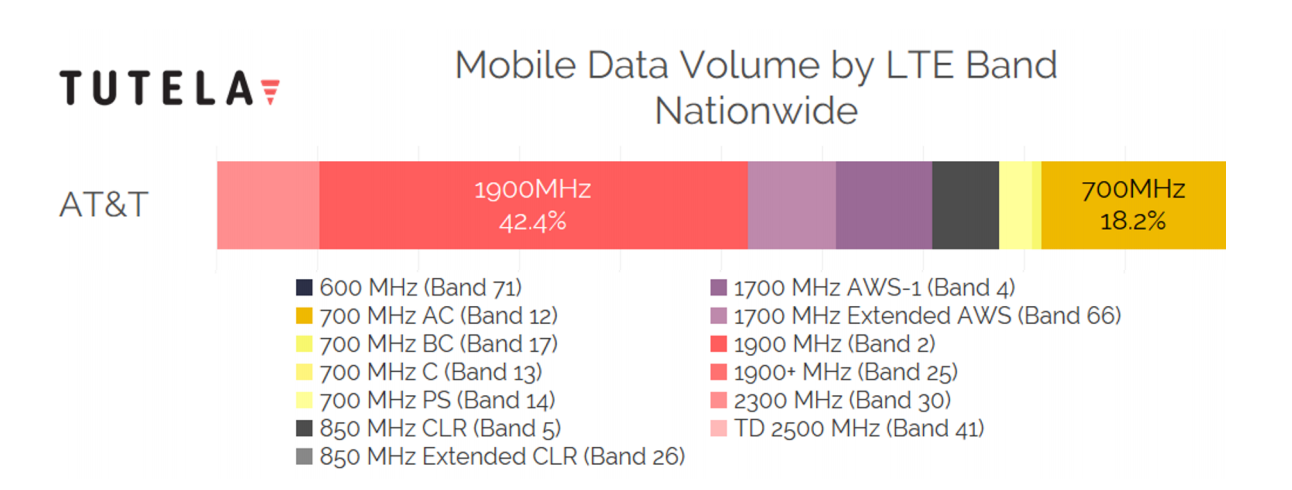
AT&T mobile data volume. | Image credit – Tutela
AT&T has built a vast 4G LTE network across the United States, supporting bands 2, 4, 5, 12, 17, 29, 30, and 66. The core of this network, however, relies heavily on bands 12, 17, and 29 within the 700 MHz range. Since bands 12 and 29 are essentially supersets of band 17, they’re often grouped together as a single foundational part of AT&T’s LTE coverage.
The remaining bands 2, 4 and 5 are mostly used in areas where AT&T does not have band 12/17, while in the densely populated metros, AT&T combines spectrum from multiple bands for better coverage. This is the reason why it is important that your phone supports all and not just one of these bands, in order for you to make maximum use of 4G LTE speeds.
Here is a breakdown of all the individual bands LTE bands that AT&T uses and their role:
- Band 2 (1900 MHz frequency range): a core AT&T LTE band with 20x20MHz blocks in most markets.
- Band 4 (AWS-1700/2100 MHz): this AT&T LTE band is used as a supplement for improved capacity and is usually deployed in small, 5x5 MHz blocks.
- Band 66 (AWS-3-1700/2100 MHz): AT&T LTE band 66 is a superset of band 4, meaning that it includes all of the band 4 blocks plus adds a few more. AT&T usually deploys this in 10x10 chunks, and you could commonly see it in the New York and New Jersey areas.
- Band 5 (850 MHz): this AT&T LTE band is used most commonly 3G (HSPA+ ) connectivity, but some of it also goes toward LTE. AT&T owns a lot in this frequency range throughout the nation, and band 5 is sometimes used in areas where there is no band 12/17 coverage.
- Band 12/17/29 (700 MHz): the backbone of AT&T's LTE network and it provides practically a nation-wide coverage.
- Band 14 (700 MHz): AT&T has a nationwide license for band 14.
- Band 30 (WCS 2300 MHz): another supplementary band for 4G LTE. AT&T has deployed chunks of 10x10 across the nation.
Verizon Wireless frequency bands
What LTE bands does Verizon use?
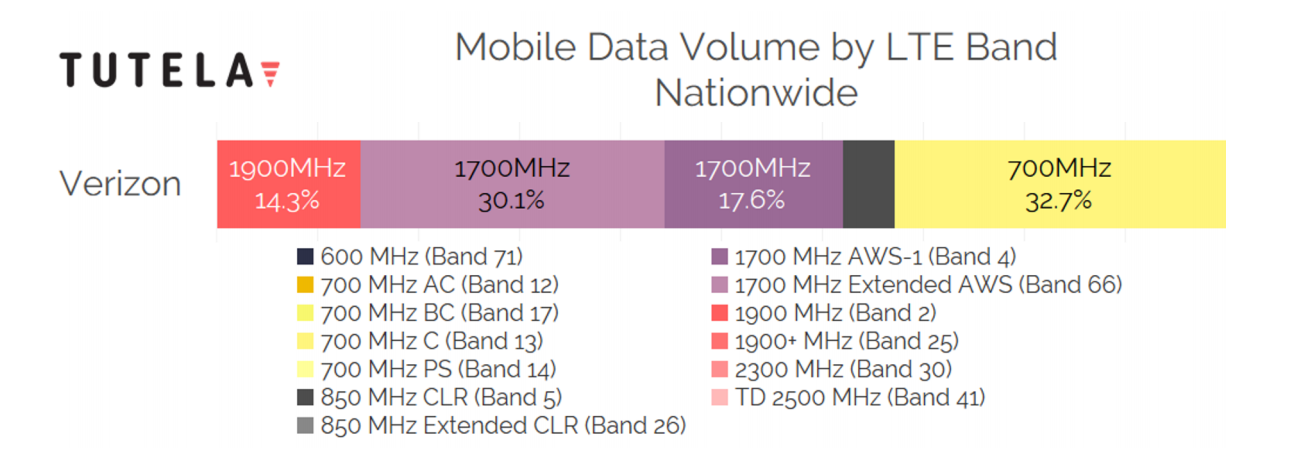
Verizon Wireless mobile data volume. | Image credit – Tutela
Verizon Wireless was the first to arrive to the 4G LTE race and it has also built its nationwide network based on 700 MHz spectrum, but the primary band for Verizon is band 13.
Bands 2 and 4 are used to strengthen the signal in the densely populated urban areas. One important thing to note about Verizon Wireless is that many phones are built specifically for the carrier, including its 4G LTE bands. In other words, the common case is that you will not be able to use an AT&T device on Verizon's 4G LTE network.
Here is a detailed breakdown of the 4G LTE Verizon bands in use:
- Band 2 (1900 MHz): This Verizon band is currently a supplementary carrier that brings more capacity to the network and is commonly deployed in 10x10 chunks.
- Band 4 (1700/2100 MHz): This Verizon band has solid amounts of these bands that it deploys in larger, 20x20 MHz blocks in many markets.
- Band 66 (1700/2100 MHz): this is a superset of band 4 (meaning that it has all the frequencies of band 4, plus a few additional blocks). It is usually deployed in small chunks and it not available everywhere.
- Band 5 (850 MHz): A Verizon band still in use for 2G/3G services in some markets, while for others, it is using this band for LTE. Verizon holds a lot of this spectrum nationwide and usually deploys it in 10x10 blocks.
- Band 13 (700 MHz): A Verizon band that is the backbone of the Verizon Wireless 4G LTE network. Verizon has this rolled out to most markets across the nation, but since it is usually deployed in rather small 10x10 chunks, it could become congested fairly easily.
- Band 46: these are frequencies in the 5.9 GHz spectrum that the carrier has started using as of 2020.
- Band 48: this is CBRS band that has been in use since September of 2019.
T-Mobile bands
What LTE bands does T-Mobile use?
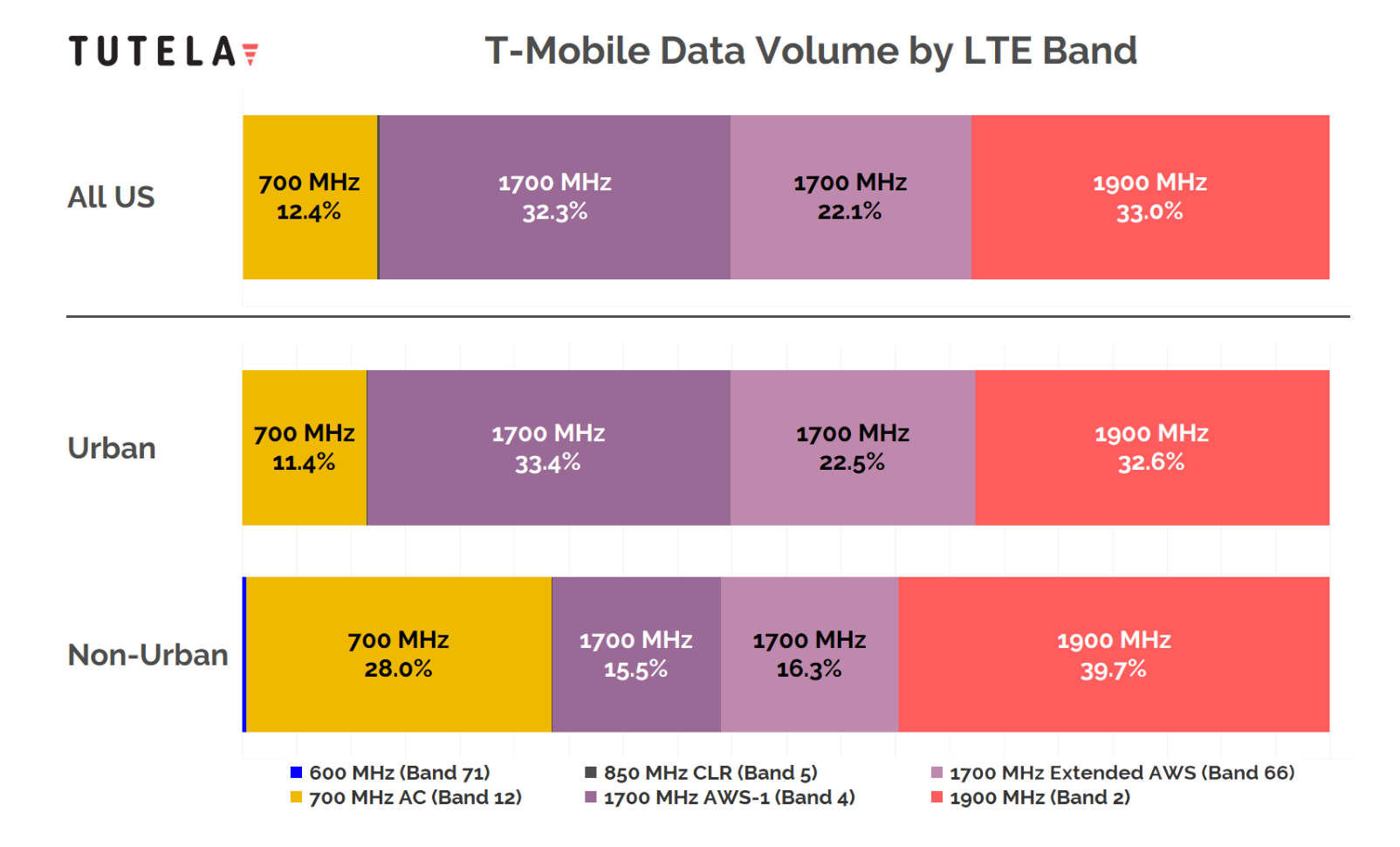
T-Mobile 4G LTE data by volume. | Image credit – Tutela
T-Mobile has been making waves with its rapidly growing 4G LTE network, particularly in urban areas. Its primary band, band 4 (AWS) at 1700 MHz, is used in densely populated regions where stability is key, though it doesn’t have quite the same penetration strength as band 2.
T-Mobile originally used band 4 for its HSPA+ networks but repurposed it for 4G LTE, expanding its coverage further with the MetroPCS acquisition. In areas where band 4 isn’t available, T-Mobile relies on band 2, often found in rural and suburban zones. In regions with both, the two bands are combined to strengthen coverage.
And here is an overview of all the bands:
- Band 2 (1900 MHz frequency range): this is a band mostly used in rural areas, or where band 4 is not available. It has higher reach, and it is widely used in the Northeast to provide 4G coverage to distant places. T-Mobile has deployed various chunks of spectrum, from smaller 5x5 blocks to larger and speedier 20x20 blocks. This band is also used for 2G and 3G.
- Band 4 (1700 MHz/2100 MHz): the backbone of T-Mobile's LTE network. This T-Mobile band is usually deployed in large 20x20 MHz chunks in most markets, providing fast speed and a stable connection. Used for more densely populated areas.
- Band 5 (850 MHz): Extremely limited use. Most band 5 coverage is offered by Verizon and AT&T. T-Mobile only operates LTE on this band around the Myrtle Beach, South Carolina area.
- Band 12 (700 MHz): This is T-Mobile's "extended range LTE" band, used mostly as a complimentary band for coverage in rural and suburban areas, and it is similar to band 71 in function. It is supported on most phones.
- Band 66 (1700/2100 MHz): an extension (superset) of band 4, this band is supported on devices since late 2016.
- Band 71 (600 MHz): the big win of the FCC auction for T-Mobile, this band was previously used by UHF TV stations. Since this is a 600 MHz range band, it has wider coverage and improved coverage inside buildings.
Europe, UK and China 4G LTE bands, 4G LTE support in phones
While the 700 MHz range in various bands has been the backbone of the US 4G LTE coverage, in Europe and China carriers use different spectrum and bands, so phones from the United States may not work there.
4G LTE bands in Europe
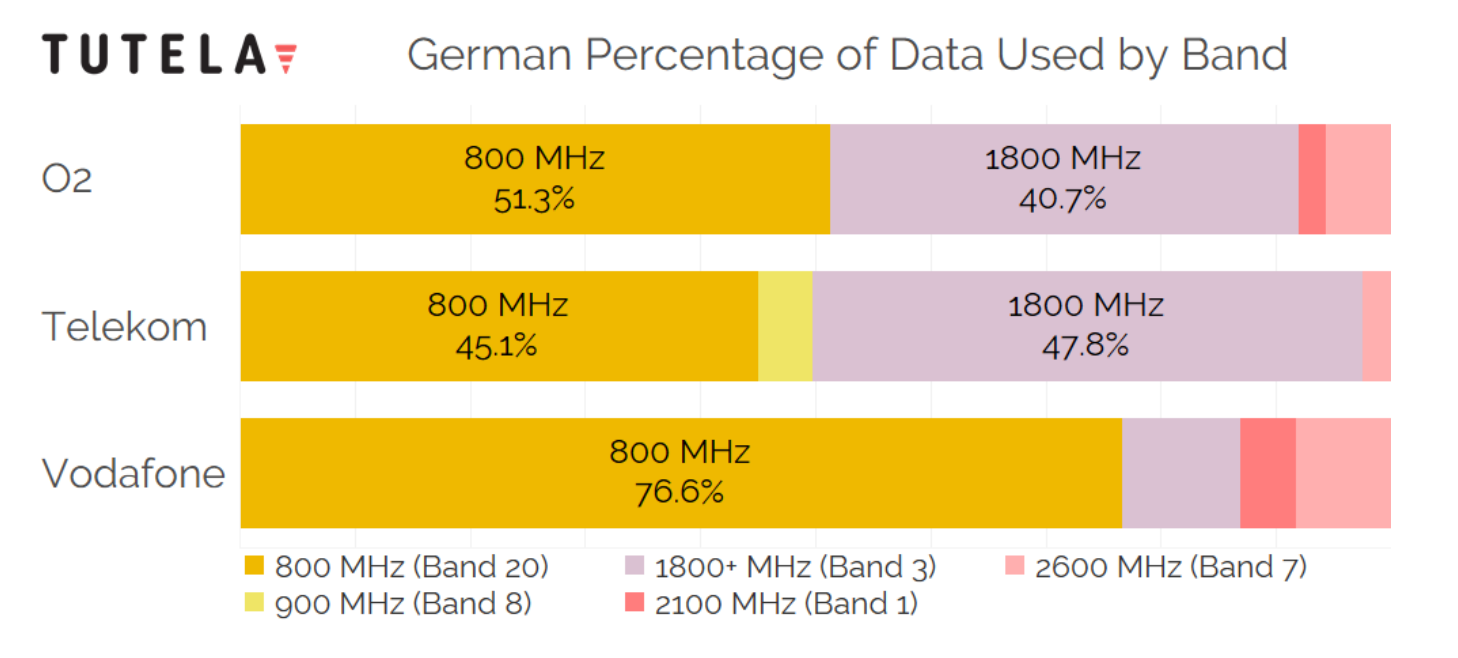
4G LTE bands used by carriers in Germany. | Image credit – Tutela
In Europe, most carriers base their networks on bands 3 (1800 MHz), 7 (2600 MHz) and 20 (800 MHz). Some carriers in the Old Continent use B1, and others also use B28, but the backbone of most carriers' 4G LTE networks are B3, B7 and B20.
Of course, as you can see in the chart above, there are differences even between carriers. In the example of Germany, the local division of Vodafone relies heavily on low-band 800 MHz B20 spectrum, while O2 and Telekom have built networks way more reliant on mid-band 1800 MHz spectrum (band B3).
4G LTE bands in the UK
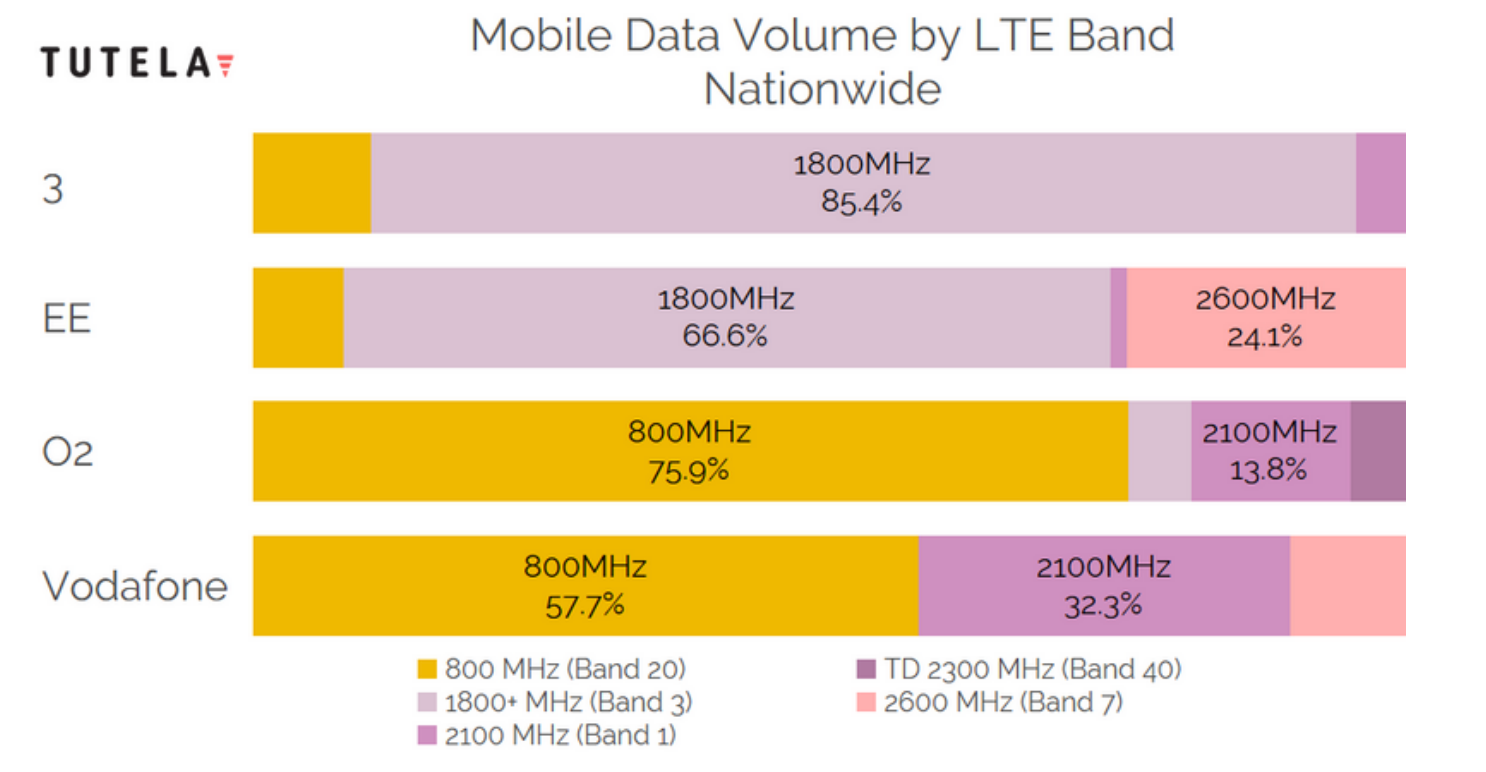
4G LTE bands used by carriers in the United Kingdom. | Image credit – Tutela
In the United Kingdom, similarly, carriers differ quite a bit in their implementation of 4G LTE networks. UK carriers EE and 3 use mid-band and high-band spectrum most of the time which results in higher speeds, but lower coverage, while Vodafone and O2 use 800MHz low-band spectrum a lot more resulting in better rural coverage, but slightly slower overall speeds.
4G LTE bands in India

4G LTE bands by carriers in India. | Image credit – Tutela
In India, the most common LTE bands are B3, B40, and B41. However, there are differences depending on the carrier. The largest carrier in India, Jio, bases its network on bands B3, B5 and B40, leaning much heavier on low-band 850MHz band B5 than other carriers.
Vodafone Idea, on the other hand, uses band B40 very sparsely, and the majority of that network is build on B1, B3, B8, B41. And Airtel, the third-largest carrier in India, uses B1, B3, B8 and B40.
China, on the other hand, uses a whole different 4G LTE standard - while the Western world has rolled out FDD-LTE networks, China and large parts of Asia use TDD-LTE. The differences between FDD and TDD are purely technical and the main one boils down to the fact that FDD is symmetrical (1:1 upload vs download), while TDD allows variable up / down ratio. The main bands for China are TD bands 40 and 41. More recently, China has also reallocated bands B1 and B3 to be used for its 4G LTE networks.
Follow us on Google News





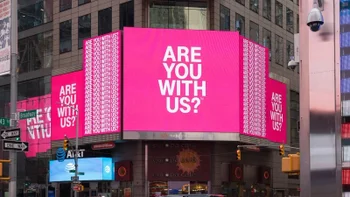
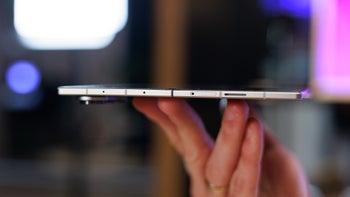






Things that are NOT allowed:
To help keep our community safe and free from spam, we apply temporary limits to newly created accounts: